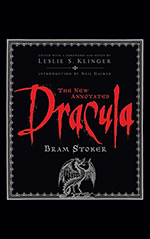
![]() charlesdee
charlesdee
4/30/2019
![]()
I've just spent a week nerding-out on Dracula. I've been meaning to reread it, although 'reread" may not be the right term when that first and only reading was a little more than half a century ago. I decided to complement the experience by getting one of the several annotated versions. I chose the one by Leslie S. Klinger.
Klinger produced the three-volume Complete Sherlock Holmes annotation, and he has an approach I don't find engaging. In both the Holmes and Dracula, his editorial material begins with the assumption that the stories are true, and his job is partially to pick apart the fiction and the facts behind the narratives. With Dracula he establishes this in the introduction, and I skimmed over that part and those later notes concerned with accurately dating the true events against the chronology in the novel. By ignoring his primary editorial conceit, you can find pure nerd gold. The history of King's Cross St Pancras station. Travel times between London and Amsterdam. The lowdown on "brain fever," that rampant Victorian malady. There are maps of relevant London neighborhoods and smudgy photographs of settings from Exeter to the Borgo Pass.. The annotations expand the novel by at least fifty percent, but you can easily pick and choose the material you find interesting or genuinely explanatory. The glossary of the Whitby dialect is essential if you want to understand the characters in the second section of the novel
Stoker's novel holds up well. Readers put off by outrageous coincidences may have a rough time, but Stoker keeps things moving. He did, after all, spend most of his life in the theater business. The opening section with Jonathan Harker in Dracula's castle is classic horror writing: atmospheric, bloodthirsty, and with a growing sense of panic. Harker and Mina, his fiancée he marries after surviving Transylvania, are a solid middle-class couple with a modern approach to marriage and careers. They are a good team, until Mina starts losing blood to the Count. The upperclass Lucy is simpering vampire bait, and her three paramours go after the vampire like public schoolboys on a foxhunt. I had never realized that their leader Dr. Van Helsing is a pompous bore, or it could be that his character hasn't aged well over the past century. The character who never disappoints is the zoophagous lunatic Renfield. As the victim of both questionable psychiatry and vampiric mesmerism, he remains one of the more sympathetic characters in the novel.